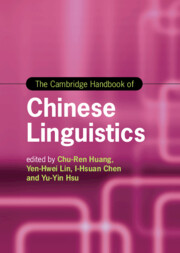Book contents
- The Cambridge Handbook of Chinese Linguistics
- Cambridge Handbooks In Language and Linguistics
- The Cambridge Handbook of Chinese Linguistics
- Copyright page
- Contents
- Figures
- Tables
- Contributors
- Acknowledgments
- Part One Writing System/Neuro-cognitive Processing of Chinese
- Part Two Morpho-lexical Issues in Chinese
- Part Three Phonetic-phonological Issues in Chinese
- 11 The Morphophonology of Chinese Affixation
- 12 Mandarin Chinese Syllable Structure and Phonological Similarity
- 13 Tonal Processes Defined as Articulatory-based Contextual Tonal Variation
- 14 Tonal Processes Defined as Tone Sandhi
- 15 Tonal Processes Conditioned by Morphosyntax
- 16 Tone and Intonation
- 17 Evidence for Stress and Metrical Structure in Chinese
- 18 Perceptual Normalization of Lexical Tones
- Part Four Syntax-semantics, Pragmatics, and Discourse Issues
- Index
- References
14 - Tonal Processes Defined as Tone Sandhi
from Part Three - Phonetic-phonological Issues in Chinese
Published online by Cambridge University Press: 04 August 2022
- The Cambridge Handbook of Chinese Linguistics
- Cambridge Handbooks In Language and Linguistics
- The Cambridge Handbook of Chinese Linguistics
- Copyright page
- Contents
- Figures
- Tables
- Contributors
- Acknowledgments
- Part One Writing System/Neuro-cognitive Processing of Chinese
- Part Two Morpho-lexical Issues in Chinese
- Part Three Phonetic-phonological Issues in Chinese
- 11 The Morphophonology of Chinese Affixation
- 12 Mandarin Chinese Syllable Structure and Phonological Similarity
- 13 Tonal Processes Defined as Articulatory-based Contextual Tonal Variation
- 14 Tonal Processes Defined as Tone Sandhi
- 15 Tonal Processes Conditioned by Morphosyntax
- 16 Tone and Intonation
- 17 Evidence for Stress and Metrical Structure in Chinese
- 18 Perceptual Normalization of Lexical Tones
- Part Four Syntax-semantics, Pragmatics, and Discourse Issues
- Index
- References
Summary
This chapter reviews the descriptive patterns of tone sandhi in Chinese dialects along with the experimental investigations of what generalizations native speakers make regarding these patterns, how they process them in production and perception, and how children acquire these patterns. Theoretical issues that tone sandhi sheds light on, including the role of typology in synchronic theories, feature representation, productivity and learnability, and the interface between phonology and other domains such as phonetics, processing, and morphosyntax, are also discussed briefly. The chapter focuses on the interdisciplinary nature of tone sandhi research and calls on researchers to take an open and synergistic approach among different methods to gain an comprehensive understanding of the phenomenon.
- Type
- Chapter
- Information
- The Cambridge Handbook of Chinese Linguistics , pp. 291 - 312Publisher: Cambridge University PressPrint publication year: 2022



